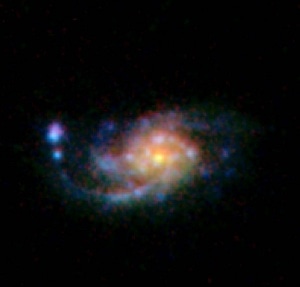Jun 19 2019
Under the guidance of Crystal Martin and Stephanie Ho from the University of California, Santa Barbara, a team of astronomers has identified a spiraling cosmic choreography among standard star-forming galaxies. Their tranquil halo gas seems to be in line with the galactic disks, as it spins in the same direction.
 J165930+373527 is among the galaxies detected with corotating halo gas. This high-resolution NIRC2 image (RED) combined with Hubble Space Telescope WFC3 Imaging (BLUE AND GREEN) resolves the galactic disk. The galactic rotation was measured from W. M. Keck Observatory and Apache Point Observatory emission-line spectra. (Image credit: W. M. Keck Observatory)
J165930+373527 is among the galaxies detected with corotating halo gas. This high-resolution NIRC2 image (RED) combined with Hubble Space Telescope WFC3 Imaging (BLUE AND GREEN) resolves the galactic disk. The galactic rotation was measured from W. M. Keck Observatory and Apache Point Observatory emission-line spectra. (Image credit: W. M. Keck Observatory)
With the help of the W. M. Keck Observatory, the astronomers obtained the first-ever direct observational evidence demonstrating that corotating halo gas is not just possible but also common. The study outcomes indicate that the swirling gas halo will ultimately spiral in toward the disk.
This is a major breakthrough in understanding how galactic disks grow. Galaxies are surrounded by massive reservoirs of gas that extend far beyond the visible portions of galaxies. Until now, it has remained a mystery how exactly this material is transported to galactic disks where it can fuel the next generation of star formation.
Crystal Martin, Study Lead Author, Professor of Physics, UC Santa Barbara
The research, which has been reported in The Astrophysical Journal on June 18th, 2019, shows the combined outcomes of 50 typical star-forming galaxies obtained over a period of many years.
Almost 10 years ago, theoretical models estimated that the angular momentum of the spinning cool halo gas partially counterbalances the gravitational force pulling it toward the galaxy, thus decreasing the gas accretion rate and extending the period of disk expansion.
The study outcomes validate this theory and reveal that the angular momentum of the halo gas is sufficiently high to decrease the infall rate but not sufficient to completely stop feeding the galactic disk.
Methodology
Initially, the astronomers acquired spectra of bright quasars behind star-forming galaxies to identify the invisible halo gas through its absorption-line signature in the quasar spectra. Then, they used Keck Observatory’s laser guide star adaptive optics (LGSAO) system and near-infrared camera (NIRC2) on the Keck II telescope, in combination with Hubble Space Telescope’s Wide Field Camera 3 (WFC3), to acquire high-resolution images of the galaxies.
What sets this work apart from previous studies is that our team also used the quasar as a reference ‘star’ for Keck’s laser guide star AO system. This method removed the blurring caused by the atmosphere and produced the detailed images we needed to resolve the galactic disks and geometrically determine the orientation of the galactic disks in three-dimensional space.
Stephanie Ho, Study Co-Author, Physics Graduate Student, UC Santa Barbara
Then, the astronomers used the Low-Resolution Imaging Spectrometer (LRIS) at Keck Observatory and also obtained spectra from Apache Point Observatory to measure the Doppler shifts of the gas clouds. This allowed them to ascertain the direction in which the gas is spinning as well as its speed.
The data demonstrated that the gas rotates in the same direction as the galaxy and that the angular momentum of the gas is not stronger than the gravitational force, indicating that the gas will spiral into the galactic disk.
Just as ice skaters build up momentum and spin when they bring their arms inward, the halo gas is likely spinning today because it was once at much larger distances where it was deposited by galactic winds, stripped from satellite galaxies, or directed toward the galaxy by a cosmic filament.
Crystal Martin, Study Lead Author, Professor of Physics, UC Santa Barbara
Next Steps
For Martin and her colleagues, the next course of action is to evaluate the rate at which the halo gas is being pulled into the galactic disk. A comparison of the inflow rate with the star formation rate will offer a better timeline of the development of typical star-forming galaxies, and describe the way galactic disks continue to expand over very long timescales spanning billions of years.